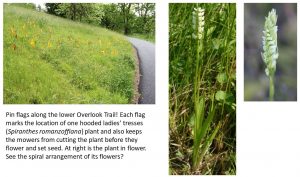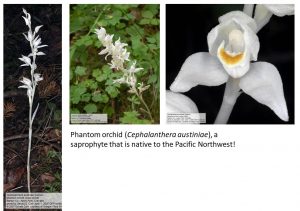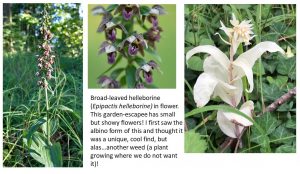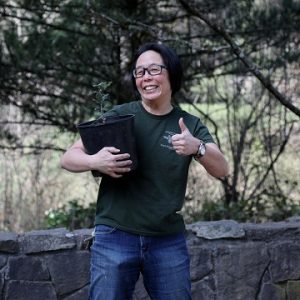Hoyt Arboretum is known for trees, not orchids. We don’t have fancy greenhouses to grow tropical epiphytic orchids. Nor do we have deep, complex older-growth forests that might have our native terrestrial orchids, such as calypso orchids (Calypso bulbosa), coralroots (Corallorhiza spp.), or twayblades (Neottia spp.). The grounds of Hoyt Arboretum, however, do have three naturally-occurring species of orchid (members of the family Orchidaceae): two natives and one non-native, weedy garden escape.
First, our most obvious and showy orchid is hooded ladies’ tresses (Spiranthes romanzoffiana), a native perennial herb that occurs sporadically across much of the western U.S. in wetlands and sometimes rocky, grassland habitats, and likely thrives in places with disturbance. It never seems to occur in any real abundance, and I first encountered this species in the early 1990s when I was doing my undergraduate research in higher-elevation wetlands at Mount St. Helens and so have always thought of it as a wetland species. In the Portland area, hooded ladies’ tresses have only been documented at Elk Rock Island in open basalt, weedy grassland areas, and at Hoyt Arboretum!
Three patches of this orchid are located along the lower portions of the Overlook Trail, between the Vietnam Veterans Memorial parking lot and up the stairs to where the trail crosses Knights Blvd. This is a grassy, weedy, sunny hill slope that is regularly mowed. First identified here in 2011, this species was probably once much more widespread, and the population that we have now is likely a remnant of its former range. This orchid soon became part of a community science project to study how best to increase its population numbers. Currently, we have several hundred plants in these three patches, and every year we take an overall census of plants and flowering stalks. In late April to early May, its basal rosette of fleshy leaves emerge and soon-after we place pin-flags to identify the location of each plant for our population count. Flowering stalks with its spiral clusters of small, white flowers typically appear sometime in June. By July, the plants have mostly dried-up and go dormant for the late summer to winter months. We know that cutting-off the flowering stalks prevents seed-set (obviously!), but it is uncertain if regular mowing helps or hinders its survival by reducing competition for water, light, and other resources.


Our second orchid is even more rare. I found just one plant (with two stems!) of a phantom orchid (Cephalanthera austiniae) in 2018 in the forested area just north of the Vietnam Veterans Memorial. I was unable to locate this plant or find any others in 2019. Phantom orchid is one of those strange saprophytic orchids, which means that it survives off of dead and decaying material on the forest floor (through symbiotic mycorrhizae) and has no green leaves or stems for photosynthesis. This orchid is entirely white, except for a few yellow markings on the inside of its flowers. I have seen this native orchid in dense forests in the Columbia Gorge area, and it was a totally unexpected find here at the Arboretum, as I typically associate phantom orchids with dense forest habitats. I assume that this plant is a relic from when vast forests covered this region.


Finally, the third species of orchid in the Arboretum is a non-native weed (spreads on its own, may outcompete and crowd out native plants) that I first encountered in summer 2019. It is a broad-leaved helleborine (Epipactis helleborine), and I initially thought that we had another cool phantom or saprophytic orchid, as it was completely white-pink in color! It turns out that we had 6-8 “normal” green broad-leaved helleborines nearby, and the one that caught my eye was simply an albino form (which apparently does sometimes occur with this species).


Broad-leaved helleborine is native to Eurasia, and it has been said that the species was intentionally planted in the Cloud Forest area of Washington Park in the 1990s. It may have been transplanted into the arboretum by well-meaning visitors, or more likely spread via seeds that hitchhiked on someone’s boots or dog fur from a nearby garden or infested site. I manually removed all plants of broad-leaved helleborine in 2019 and made herbarium specimens of some of them. I was planning on also doing so for the one albino plant, but in my wait for it to flower, someone took it (or an animal ate it). Harumph!
Please keep an eye out for these orchids as you explore the Arboretum, and let us know if you find any of them outside of their already known areas!
Images from:
Mike Drewry
Burke Herbarium Image Collection
Oregon Flora Project Photo Gallery
Dr. Mandy Tu works for Portland Parks & Recreation as the Plant Taxonomist and Herbarium Curator at Hoyt Arboretum. In this position, she is responsible for collecting voucher specimens and verifying the identity of the trees within the Arboretum and is often asked to identify plants by natural area managers in the Portland region. She has a B.S. in Botany from the University of Washington and a Ph.D. in Plant Biology from the University of California at Davis. Mandy has taught many plant identification courses and workshops for botanical professionals and plant enthusiasts.

